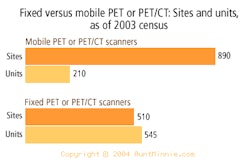CHICAGO - Doctors who treat or diagnose patients with radioactive biological agents -- such as iodine-131 or thallium-201 -- should warn patients that they can set off highly sensitive handheld radiation detectors that have become ubiquitous on public transportation, at public buildings such as courthouses, and at major sporting events.
Some radiation can trigger alarms up to three months after the patient has been treated, said Dr. Lionel Zuckier, professor and director of nuclear medicine at the New Jersey Medical School, University of Medicine and Dentistry of New Jersey in Newark.
At the urging of Gary Garetano, assistant director of the Hudson Regional Health Commission in New Jersey, Dr. Zuckier analyzed how long common biological agents could remain potent enough in a person's body to set off radiation detectors -- 10,000 of which have been distributed to law enforcement and Homeland Security personnel in the U.S. and in U.S. agencies abroad.
"It is actually sort of reassuring that these devices can pick up radiation inside a person's body," Dr. Zuckier said Tuesday at the RSNA meeting. "However, it can be an inconvenience for the patient and others."
He cited a case in March 2003 in which a patient treated with a radioisotope boarded a bus -- against his doctor's advice -- going from New York to New Jersey. When the bus entered a Hudson River tunnel, a radiation detector went off, the bus was pulled over, and everyone was detained until authorities determined that it was a medical use of radioactive material and not a terrorist carrying nuclear material.
"We suggest that patients who are treated with nuclear materials carry with them a card or letter from their doctor explaining why they are emitting radioactivity and a number for authorities to call to confirm the situation," Dr. Zuckier said in a press briefing.
Dr. Philip Alderson, professor of radiology at Columbia University in New York and moderator of the RSNA briefing, said the card or letter should have the number of the hospital radiation safety officer who would have access to a list of patients undergoing treatments with radioactive medicinals.
Dr. Zuckier listed the following agents and the number of days a person would be "hot" enough to trigger one of the devices:
| Fluorodeoxyglucose (FDG) | 1 day |
| Iodine-123 | 3 days |
| Technetium-99 | 3 days |
| Indium-111 | 4-17 days |
| Thallium-201 | 30 days |
| Iodine-131 | 95 days |
Medical and government agencies suggest passengers carry the notes, which are similar to those carried by passengers who have implanted devices, but there are no official guidelines on how long a person should carry them.
"People who have been injected with radioactive materials should expect to be detected at airports or on public transportation," Dr. Zuckier said. "I noticed that they (detectors) were being worn by U.S. customs officials at the airport in Calgary (Alberta, Canada). The policy on what to carry is evolving."
By Edward Susman
AuntMinnie.com contributing writer
November 30, 2004
Related Reading
"Dirty bomb" fears hurt medical isotope transit, UN says, September 3, 2004
Olympics security highlights imaging and radiation technology, August 13, 2004
Copyright © 2004 AuntMinnie.com




















